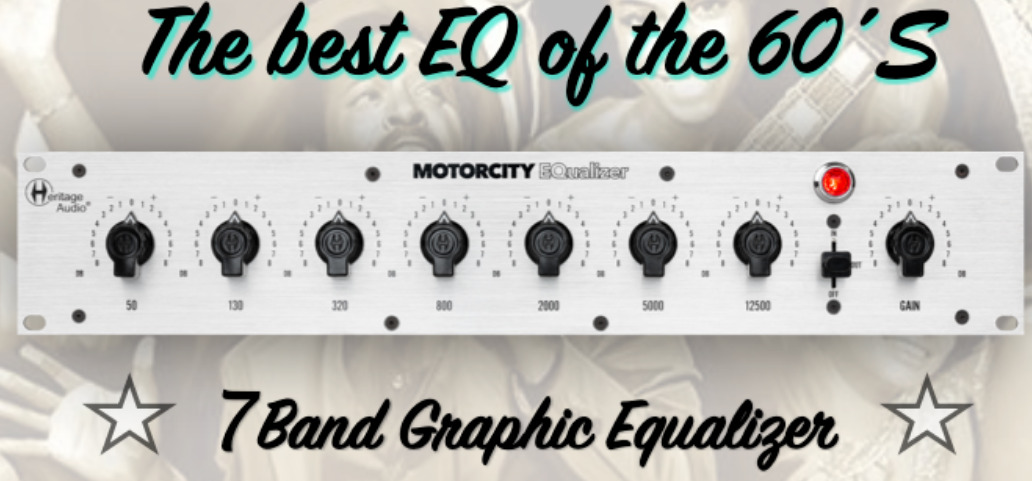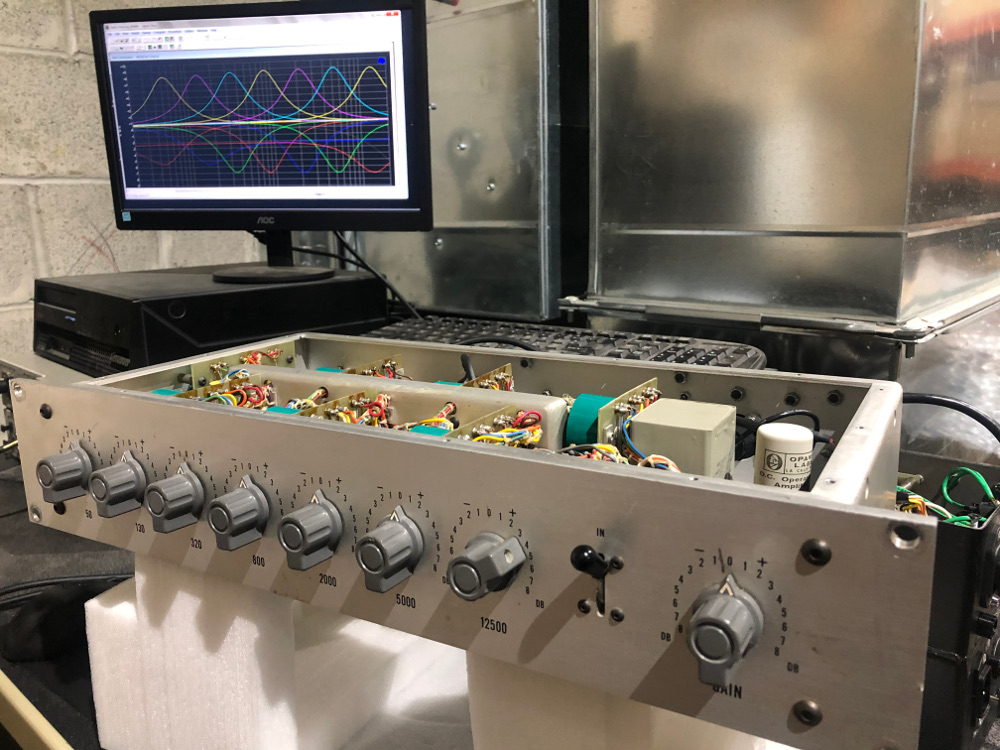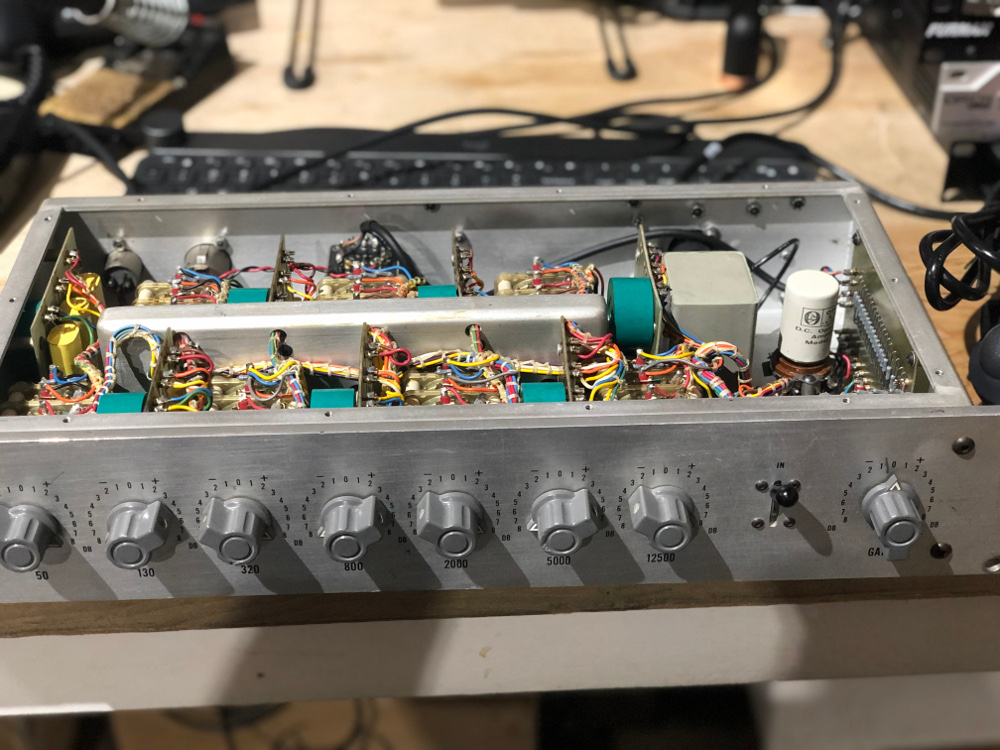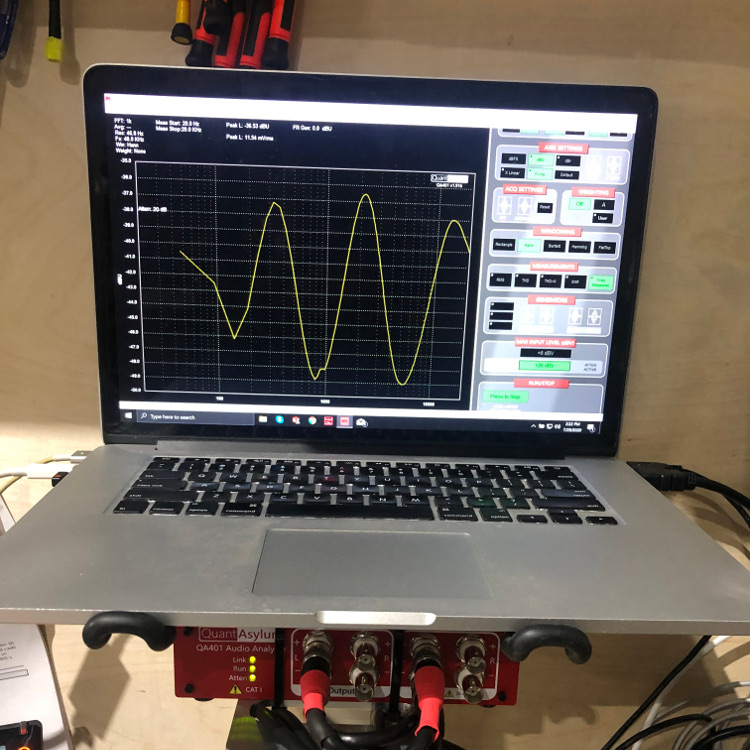Studio Gear R&D: The Heritage Audio MOTORCITY EQualizer
If you could travel back in time and help yourself to one piece of gear from Hitsville U.S.A. what would it be?
Also known as the hallowed ground that is Motown, the historic Detroit studio that was Hitsville didn’t just produce hits. It was also the origin of some of the most sought-after analog gear known to audio – now-classic units that recorded, mixed, and mastered timeless tracks by Marvin Gaye, Stevie Wonder, Martha and the Vandellas, Smokey Robinson & The Miracles, The Temptations, Four Tops, Smokey Robinson, Gladys Knight & The Pips, The Jackson 5, Diana Ross, and many more.
One of the vintage units produced on the Hitsville workbench was the Motown EQ, a deceptively simple analog 7-band EQ developed by famed Motown Engineering Department Head Mike McLean. Like other Motown-borne gear, these EQs proved to have their own electrifying mojo. That’s why two of these sought-after boxes made their way into the esteemed outboard racks of platinum mixer Michael Brauer (Coldplay, John Mayer).
And that’s where our story begins. When Brauer showed up at the door of his trusted friends at Black Lion Audio to tune them up, he had no idea he was about to blow things wide open. Black Lion’s Seth Berman received the units and, standing face-to-face with historical gear, got Brauer’s blessing to do something very special: recreate his Motown EQs for all the audio world to access.
New York-based Black Lion Audio contacted their friends at Heritage Audio – an ocean away in Madrid, Spain – to do just that. Knowing that Heritage’s equally inspired CEO Peter Rodriguez has always wanted to recreate these EQs, he assumed the lead, and the two sonic companies combined to create the Heritage Audio MOTORCITY EQualizer. True to its name, it levels the game by making a $40K-if-you-can-find-one unit accessible to many more modern studios, now with a $1,999 price tag.
A completely analog, passive EQ design with seven accessible frequency points across the tonal spectrum, each frequency of the MOTORCITY EQ has a stepped rotary switch capable of a flat response, or up or down up 8db in 1dB increments. It’s frequency points graduate from 50hz, 130hz, 320hz and 800hz, and then at 2000hz, 5000hz, with a 12,500hz peak. There are 21 inductors and 21 tone capacitors, three each per band, custom made to match Michael Brauer´s values to 1% tolerances. While both the sound and look are pure vintage, technical updates amp up the MOTORCITY’s reliability and integration with modern mixing rigs.
This “Research & Development” gives the inside perspective from Berman and Rodriguez, on their drive to make the unobtainable readily available.

The MOTORCITY EQualizer shouts ’60’s out loud.
Buy it new on Sweetwater or Thomann. Look for deals on Reverb.
Beginning with Brauer
Seth Berman: Today there are hundreds of audio manufacturers, but back then when a studio needed gear, they had somebody on staff that made it. A couple of Motown’s engineers were making these EQs. They also made their preamps, their master section, their EQ section for cutting vinyl…Motown made these EQs for themselves.
They never sold them. They were always made for in-house use, but subcontracted the manufacturing of 20-30 units for their studios in Detroit and LA, but there’s so few of them. There’s literally no record. We believe there’s between about 20 or 30, and over time, even in those 20 or 30, there are several different versions. Motown might have made five, decided there was a better way to do it, made a change and then the next 10 were made another way. Then they made another change, and the next five were made another way.
We got lucky in that Michael Brauer came to me one day and asked if we could spruce his units up. They were getting a little long in the tooth and needed some TLC. I had his two units with me and I realized what I actually had. Being as we are so close with Heritage Audio that we talked to them on a daily basis, we were like, “Hey, you won’t believe what’s here!”
Peter at Heritage went absolutely insane. He said, “I’ve always wanted to make one of those, but I can’t even get one to be able to run tests on it.” We very quickly decided, “Hey, why don’t we do this together?” My hands and ears in New York, your brains in Spain.
Peter Rodriguez: Nowadays there are clones of virtually anything that was made in the past. There’s plenty of information on the net for anybody from the novice to the master expert to build almost anything previously available.
However, the Motown EQ is the exception to this rule! There are no schematics available and reverse engineering was almost impossible due to the fact of the extreme scarcity of the original units available. When Brauer’s units made their appearance at Black Lion’s facilities and I was put on notice, I almost literally cried.
Not being able to travel was a real kick in the gut and made the challenge even more difficult, but even more exciting at the same time. The whole process was an engineering delight.
Remote Gear Design: Creating New Audio Hardware with a Global Team
SB: How do you design gear together on opposite sides of the planet during lockdown? We came up with this really cool collaborative process where we would spend hours a day on Skype.
I was running tests on it, measuring components and doing listening tests, because every component in this unit was custom-made back then. Peter had his tests in Spain running simulations based on my findings in New York, and most importantly trying to draw the schematics.
PR: The remote collaboration was born as a necessity. The engineering team was locked down both in Madrid and Lisboa at the time, which almost made me give up at the beginning. Then we realized that having brains, hands and eyes spread all over the world was not necessarily a bad thing!
Essentially, we set a working method pretty similar to what software engineers call “the white room,” where a set of engineers study the actual unit and another team applies what the former has acquired. We all had meetings in the New York morning and the European team spent the afternoon and good part of the night understanding what was previously discovered. This was refined day after day. It was a very rewarding process.
Uncommon Capacitors: Customizing the Components
SB: Keep in mind the Motor City EQ was never really an official product designed for the mass market. They were never available in a store, and never sold by dealers. So even finding information about how they were made, when they were made, where parts were sourced from is incredibly difficult.
PR: As a man who loves challenges, it was mostly the challenges that made this project incredibly exciting.
As a great anecdote, I would highlight the final day on the reverse engineering process. We spent the previous night calculating the final resistors responsible for the 1 dB step boost and cut values, four each for each boost and cut value. We made our spreadsheet of theoretical values and set a video conference with [Seth Berman and his team in New York]. Luckily enough, the Motown unit uses military resistors with their high precision values printed on them. We asked Seth to check those values and every one of them matched our calculations with no error.
That day was a very happy one! Of course when we finished prototyping and all our EQ curves matched perfectly with those on the original was another one!
After this, only the first stage was completed, as our theoretical findings had to materialize into modern day components and a manufacturing method actually feasible. Almost every component found in the originals were custom made, even the resistors had custom values.
Having made analog outboard gear for over 10 years actually paid off when sourcing the parts. Our suppliers were used to having us push them to their manufacturing limits and never settle with standard parts.
We had to work with a very specific capacitor company to make custom parts for this unit – all the switches were custom switches, all of the transformers…
Uncovering Cost Efficiencies
PR: Here was another major challenge in the process: trying to reduce the labor costs to make it accessible to most people. On the Motown, we found that because everything was custom-made, it was as custom as custom gets. Making the unit with the same construction techniques would take literally a couple of weeks per unit. To the extent that if we were manufacturing this now the way these were made then, this would’ve been a $20,000 unit to make today.
So how do we take this classic EQ with all the correct sound components, but convert it into modern manufacturing? We had to rethink, “How does a switch work? How is the point-to-point wiring done? How do you convert all these separate modular channels into PCB style design and routing?”
It was really cool seeing that process, especially because a lot of it was not as easy as just sending a switch to a factory and saying, “Copy this.” It took a lot of asking, “How does this switch work? Why was it made this exact way?”
Nailing the Sound of Motown
SB: With the number of controls on it, you would think that this EQ is super surgical, very sterile, with a very pinpoint action to it. And it really doesn’t. The q’s are wide enough on every single band that the bands are incredibly interactive.
We found that that was one of the things that was really special and made the Motown sound the way it was – the way the channels interacted with each other. Anyone could look at the frequencies and say, “Okay, I’ll make a seven band EQ where they have sets at bands at 50, 130, 320, 800,” but it won’t sound like the Motown. We found that a lot of it had to do with the way the channels interacted with each other, and what that caused was this very broad musical EQ that just happens to have a lot of bands.
So it looks like it would be a surgical EQ, but it sounds like one of these super broad, paint brushy EQs. The MOTORCITY EQ has got so much mojo to it that just a little bit of a boost at the right frequencies or a little bit of a cut at the right frequencies just changes the entire character. It’s really incredible – I just love the way it sounds.
PR: The whole engineering process highlighted some genius thinking from the original designer. The seven bands are arranged in a very specific way which makes phase distortion negligible and interaction an unforgettable musical experience.
Approved by a Mixing Maestro
SB: Michael Brauer allowed us to hold onto his units to run all the tests. We also brought him in a couple of times during the design and testing process to say, “Hey, we know our ears and eyes when we’re looking at our test results are showing us that these are the same, but we need somebody who has more experience than anybody else – maybe in the world – of using these. Tell us that we’re still on the right track.” We had him test the feel, look, and sound of the unit.
In fact, one of the most stressful days of my entire life was when we had the final MOTORCITY EQ prototype/production unit. It was the point where everything was set in stone and this is how it is. Let’s let Michael Brauer finally sit down with it without telling him what to do with it, what to look for. Is he going to say this is just like his unit?
We actually have this recorded on someone’s phone – a Black Lion colleague filmed him sitting at my workbench, plugging in the MOTORCITY EQ and listening to it the first time to give his feedback. You could literally see me in the corner, biting my fingernails. I thought, “Man, I hope we didn’t just waste a year of our lives.” Because it literally was almost every day for an entire year of the lockdown working on one product.
And he was blown away. He basically said, “If I wanted to, I could actually sell my vintage units today and I would be able to just use these instead.” Watching him mix using this EQ was just incredible. It’s hard to explain until you see it yourself how remarkable it is, just how using the right frequencies at the right amount of boost or cut can change the entire character of a track.
Michael Brauer: The MOTORCITY EQ’s are a clone of my Motown EQs. They sound identical in every way. In fact, the output gain actually sounds even better than mine.
I used my Motowns across kick and snare of every song I’ve mixed since getting them over 20 years ago. There’s nothing out there like the sound of these MOTORCITY EQ’s.
Hear them in action on overheads, individual drum instruments, guitar and bass here:

Who the MOTORCITY EQ is Made For
SB: The MOTORCITY EQ is for anybody who wants to really add mojo and vibe to their system in EQ, which is something that has kind of gotten pushed to the back compared to preamps and compressors.
When [engineers and producers today] say, “I don’t like my sound, what else do I need?” You’ll very often see people saying, “Oh, you need a new microphone,” or “Hey, let’s look at preamp or compressor options.” EQ has kind of always come last when it comes to what a retailer recommends, or what a person thinks of as what creates their sound.
But we recognize that for a lot of things with Motown, it was actually these EQs. It was unquestionably one of the things that held together the Motown sound, these custom-made EQs that were used on everything. We realized that this thing is so good at helping you get your sound, that it doesn’t need to be the last decision anymore. You can very easily use this now to create what is now your sound.
Classic EQ, 21st Century Benefits
SB: If someone had the choice of buying the classic vintage units vs. the MOTORCITY EQ, they’d see that the new unit has some advantages.
One thing is the connections. The original ones were designed just to work in the Motown studios. We have much more robust XLR connections in the MOTORCITY EQ.
PR: Another big thing that we did is, we first noticed that on Brauer´s units was an aftermarket external power supply and some related modifications on the inside. When we asked Michael he said that the original internal one made the unit hum, which makes sense as the unit has no less than 21 inductors than need to be as far away as possible from a power transformer.
We said, “Power supply technology is just continuing to get better and better and better over time.” We found that giving it a modern power supply really helped when it came to noise and reliability. So we followed our trademark approach of using our great internal power supply, like we do in the OST 500 series enclosures, with an external wall wart transformer.
The entire unit is a little more lightweight. The original weighed something like 30 pounds – it was made of some the thickest American die cast aluminum I’ve ever seen. Not just sheet metal type of metal, but like some crazy bulletproof case. This one is still a heavy piece of gear due to having so many inductors, but we got it down to a manageable level.
Obtaining the Unobtainable
PR: The Motown EQ is the Holy Grail of equalization. Nothing comes close in terms of flexibility plus sound. And it was never available to the public until now. We are very proud to not only be the first to have made this, but also to have been able to offer it at a price where most customers will be able to enjoy it.
SB: There’s been a huge push in our industry, for the last 15 years or so, of trying to make vintage gear accessible to everyday people. This one was the next level.
This wasn’t just, “How do you make something that was expensive become affordable?” For all of us at Black Lion Audio and Heritage Audio, this was about, “How do you make something that is unobtainable obtainable?”
We might be the only people that are going to be able to do this, just because of how rare it is to get one of these. Only 20 to 30 of these were ever made, so for another one to get reincarnated is incredibly difficult.
The whole process of making the MOTORCITY EQ has helped us to recognize the value of being able to help out with classic gear that people want but can’t get. Now we know that we can say, “Let’s make it so you can get it.”
— David Weiss is an Editor for SonicScoop.com, and has been covering pro audio developments for over 20 years. He is also the co-author of the music industry’s leading textbook on synch licensing, “Music Supervision, 2nd Edition: The Complete Guide to Selecting Music for Movies, TV, Games & New Media.” Email: david@sonicscoop.com
Hi! When you buy through links on this page, we may earn an affiliate commission.
Please note: When you buy products through links on this page, we may earn an affiliate commission.










